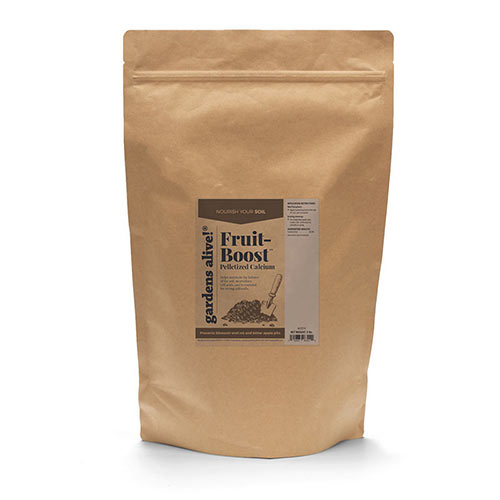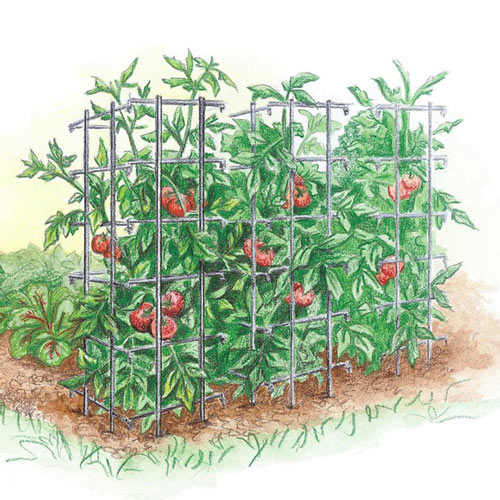What Went Wrong with my Tomatoes?!
-
Helpful Products from Gardens Alive!
-
 Fruit-Boost™ Pelletized Calcium Carbonate
Fruit-Boost™ Pelletized Calcium Carbonate -
 Tomato Cage - Plant Trellis
Tomato Cage - Plant Trellis
During my last taping, the first two phone calls I fielded were about tomatoes. Can of Corn, right? Two softballs to start the day, right? Wrong. First, I struggled with mealy tasting tomatoes and then tomatoes with black centers, feeling inadequate on both answers. But then I heard my response to one on the Podcast and the other on the TV show (different people edit those shows, and I never know what the final versions will look or sound like until I watch and/or listen to them). Turns out my answers were pretty good after all, but I still think I should have done better. So here's the 'he's had time to think about it' version.
The first call was from Amy in Indianapolis, who wanted to know why her tomatoes tasted mealy. In response to my 'stalling for time' questions, she explained that they had been deluged by tons of rain early in the season and her first crop was pretty much lost to Blossom End Rot. And then I kind of nailed it when I asked if she had used my 'crushed eggshells in the planting hole trick' and she sheepishly revealed that this was the first time in ten years she had forgotten to do it. Too much rain and lack of calcium in the soil I proclaimed. I was sweating bullets, but it tuned out to be a good diagnosis. One for me!
The Mississippi State Extension reports that the most common causes of mealy tasting tomatoes are too much water, especially early in the season; too much Nitrogen in the soil and too little potassium and calcium. They also point out that some varieties are more susceptible than others, but don't name names. And of course, they warn us to avoid the agony of defeat by never putting tomatoes in the fridge; temps below 55 degrees F. ruin the flavor and make them mealy.
Other sources also warn of too much water early in the season, especially in container-grown fruits; always use the biggest pots possible. The condition generally affects the first grown fruits, when they're still too young to process much water. (But too much water at the end of the season can also dilute the flavor. Many sources add that tomatoes grow best and develop their finest flavor in soil with a pH of around 6.5, which is just slightly acidic and also right in the perfect pH zone for most of the plants of summer. The reason goes back to calcium, as a low pH won't allow the plants to take up any calcium that IS in the soil. (If the pH is low, bring it up with agricultural lime or ashes from a hard wood stove; both of which also supply calcium.)
And finally, all sources approve of eating the fruit, but cooked, like in tomato sauce, where lots of added herbs and stuff can enhance the flavor (I use Asian hoi sin sauce for this). Search online and you'll find a surprisingly large number of 'mealy tomato recipes'; a site called "My recipes" lists 35 options!
Joanne in Abington was the second call; she DID do the eggshells, but her tomatoes developed black spots on the outside that led to black centers, which sure sounded like blossom end rot to me. And several sources agreed that the cause might be one unusual form of blossom end rot, but this form of blossom end rot doesn't cause black spots on the outside, indicating that she probably has a different problem.
Among the dizzying number of choices offered by Clemson University are:
• Early blight; caused by pathogens in the soil. Be sure to strictly observe a three year rotation of tomatoes and other crops in the solanaceous family, like potatoes, peppers and eggplant. Maybe even start a new bed and don't transfer any of the infected soil to it. In fact, don't even use the same tools. If used early, copper sprays may help limit the progression. Plant resistant varieties, named in the article.
• Bacterial Spot, which makes black spots on the outside of the green fruits but not on the inside. Heavy rain is the most common cause. Spray with copper and try and keep the leaves dry.
• Anthracnose: symptoms mesh nicely, with crowding a big cause. Provide lots of space between plants; mulch the soil with lots of compost to block transmission from soil to plant. Cage tomatoes to improve air circulation, and plant in full sun.
I could list a few other possibilities (around 250), and that's just in the North; but I'm already depressed by looking at all the dirty pictures of dying tomato plants. (See what I go through for you!) If you'd like to get equally depressed, just check your nearest State Extension website for all the terrible things that can happen to YOUR tomatoes!
But the bottom line is:
• Don't use high nitrogen fertilizers
• Mulch heavily with compost
• Space plants three feet apart in full sun in raised beds. Rotate your plants every two or three years. If you don't have that kind of room, grow fewer plants or grow your extras someplace else.
• Give them plenty of calcium!
And if impossibly nasty weather attacks, remember--there's always next year!
The first call was from Amy in Indianapolis, who wanted to know why her tomatoes tasted mealy. In response to my 'stalling for time' questions, she explained that they had been deluged by tons of rain early in the season and her first crop was pretty much lost to Blossom End Rot. And then I kind of nailed it when I asked if she had used my 'crushed eggshells in the planting hole trick' and she sheepishly revealed that this was the first time in ten years she had forgotten to do it. Too much rain and lack of calcium in the soil I proclaimed. I was sweating bullets, but it tuned out to be a good diagnosis. One for me!
The Mississippi State Extension reports that the most common causes of mealy tasting tomatoes are too much water, especially early in the season; too much Nitrogen in the soil and too little potassium and calcium. They also point out that some varieties are more susceptible than others, but don't name names. And of course, they warn us to avoid the agony of defeat by never putting tomatoes in the fridge; temps below 55 degrees F. ruin the flavor and make them mealy.
Other sources also warn of too much water early in the season, especially in container-grown fruits; always use the biggest pots possible. The condition generally affects the first grown fruits, when they're still too young to process much water. (But too much water at the end of the season can also dilute the flavor. Many sources add that tomatoes grow best and develop their finest flavor in soil with a pH of around 6.5, which is just slightly acidic and also right in the perfect pH zone for most of the plants of summer. The reason goes back to calcium, as a low pH won't allow the plants to take up any calcium that IS in the soil. (If the pH is low, bring it up with agricultural lime or ashes from a hard wood stove; both of which also supply calcium.)
And finally, all sources approve of eating the fruit, but cooked, like in tomato sauce, where lots of added herbs and stuff can enhance the flavor (I use Asian hoi sin sauce for this). Search online and you'll find a surprisingly large number of 'mealy tomato recipes'; a site called "My recipes" lists 35 options!
Joanne in Abington was the second call; she DID do the eggshells, but her tomatoes developed black spots on the outside that led to black centers, which sure sounded like blossom end rot to me. And several sources agreed that the cause might be one unusual form of blossom end rot, but this form of blossom end rot doesn't cause black spots on the outside, indicating that she probably has a different problem.
Among the dizzying number of choices offered by Clemson University are:
• Early blight; caused by pathogens in the soil. Be sure to strictly observe a three year rotation of tomatoes and other crops in the solanaceous family, like potatoes, peppers and eggplant. Maybe even start a new bed and don't transfer any of the infected soil to it. In fact, don't even use the same tools. If used early, copper sprays may help limit the progression. Plant resistant varieties, named in the article.
• Bacterial Spot, which makes black spots on the outside of the green fruits but not on the inside. Heavy rain is the most common cause. Spray with copper and try and keep the leaves dry.
• Anthracnose: symptoms mesh nicely, with crowding a big cause. Provide lots of space between plants; mulch the soil with lots of compost to block transmission from soil to plant. Cage tomatoes to improve air circulation, and plant in full sun.
I could list a few other possibilities (around 250), and that's just in the North; but I'm already depressed by looking at all the dirty pictures of dying tomato plants. (See what I go through for you!) If you'd like to get equally depressed, just check your nearest State Extension website for all the terrible things that can happen to YOUR tomatoes!
But the bottom line is:
• Don't use high nitrogen fertilizers
• Mulch heavily with compost
• Space plants three feet apart in full sun in raised beds. Rotate your plants every two or three years. If you don't have that kind of room, grow fewer plants or grow your extras someplace else.
• Give them plenty of calcium!
And if impossibly nasty weather attacks, remember--there's always next year!
-
Helpful Products from Gardens Alive!
-
 Fruit-Boost™ Pelletized Calcium Carbonate
Fruit-Boost™ Pelletized Calcium Carbonate -
 Tomato Cage - Plant Trellis
Tomato Cage - Plant Trellis







 Gardens Alive! & Supplies
Gardens Alive! & Supplies




